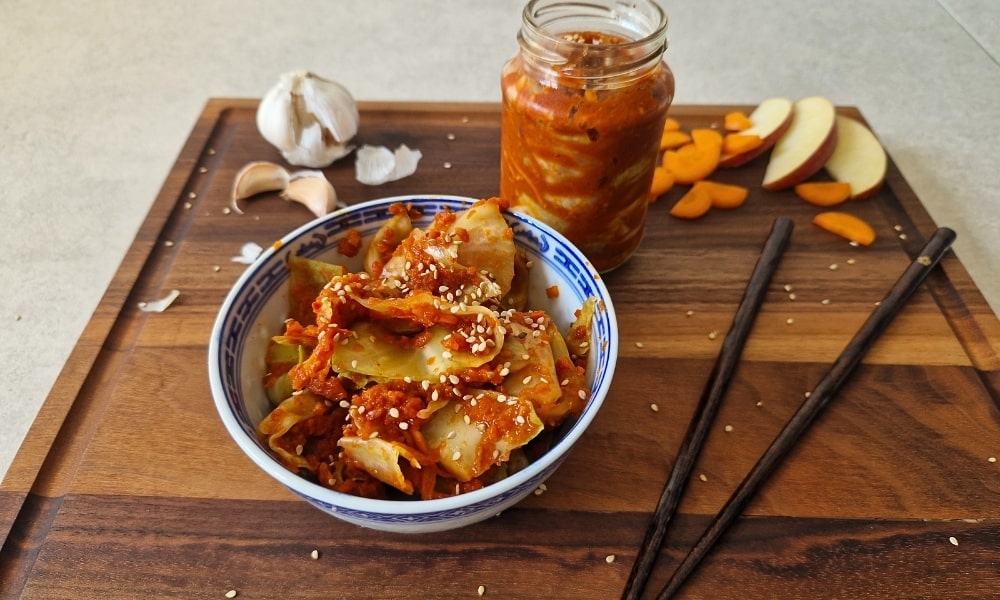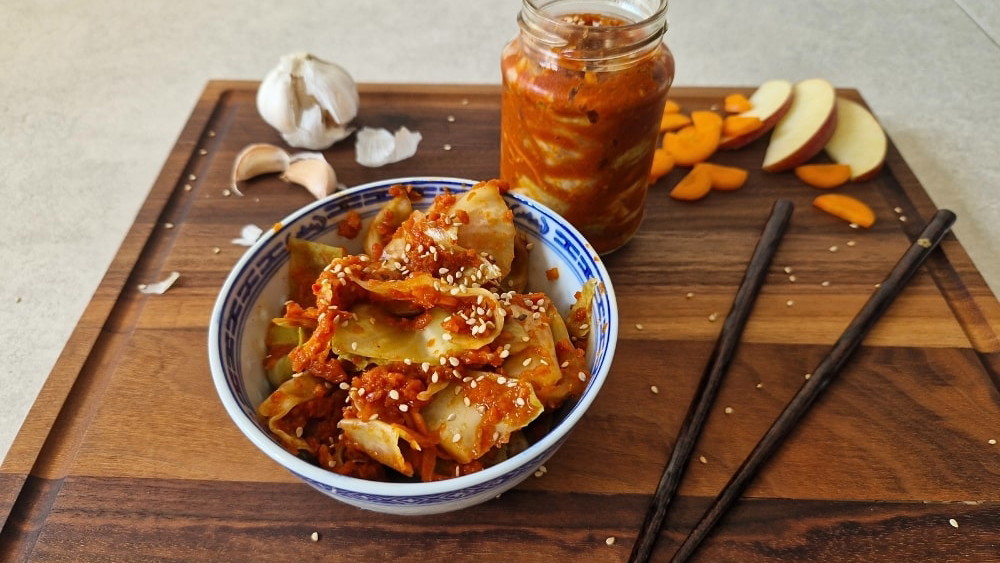Kimchi is the new superfood – and for good reason: this Korean dish is not only incredibly delicious but also super healthy. Try our vegan kimchi recipe and dive into the world of Asian cuisine.
Nutritional values per serving
Instructions
Recipe Note
Kimchi is a traditional Korean dish that's been made for over 1000 years! Over time, the ingredients have evolved, but kimchi remains deeply rooted in Korean culture. In fact, the tradition of making kimchi together (called Kimjang) is considered intangible cultural heritage!
Substitution Table
Ever wanted to cook a recipe but were missing ingredients or didn’t like some components? No problem! Use this table to adapt the vegan kimchi recipe to your liking:
• Napa cabbage → pointed cabbage, pak choi, white cabbage
• Carrot → kohlrabi, parsnip
• Radish → daikon, kohlrabi, or omit
• Apple → pear, mango, date paste
• Onion → spring onions, shallots
• Garlic cloves → wild garlic or omit
• Ginger → turmeric, galangal
• Gochugaru → smoked paprika + cayenne, chili flakes + paprika, other chili powders
• Miso paste → soy sauce, tahini + tamari
• Soy sauce → tamari
Our kimchi recipe is vegan, but feel free to use animal-based ingredients if you prefer!
Ingredients Explained
Every ingredient in this vegan kimchi recipe is carefully chosen – not random! Each one plays an important role in taste and texture:
- Napa cabbage: Crisp and great for fermentation.
- Salt: Draws water from the cabbage and supports healthy bacteria while inhibiting harmful ones.
- Carrot: Adds sweetness, crunch, and color.
- Radish: Adds a spicy kick.
- Apple: Adds sweetness and feeds the good bacteria during fermentation.
- Onion: Adds depth of flavor.
- Garlic: Essential for taste and has antibacterial properties.
- Ginger: Adds heat and freshness; supports digestion.
- Gochugaru: Adds heat and the classic red color (mild heat!).
- Miso paste: Provides umami and is fermented itself – double health benefits!
- Soy sauce: Adds savory umami flavor and ties it all together.
What is Fermentation?
Kimchi fermentation is lactic acid fermentation. This involves lactobacillus bacteria, which are actually good for you – they feed on sugar (like in apples) and produce lactic acid. This preserves the kimchi and gives it its characteristic sour flavor. Kimchi becomes probiotic and great for your gut and overall health.
Fermentation only works in airtight jars – make sure to seal your jar tightly!
Fermentation in Everyday Life
Fermentation is used in many foods: sauerkraut, yogurt, wine – even store-bought kimchi. But these are often heated after fermentation, which kills the beneficial bacteria. Our vegan kimchi recipe keeps all the benefits intact.
Why Make Kimchi Yourself?
- Ingredients: No unnecessary additives or preservatives – just what you want to eat.
- Processing: Store-bought kimchi is often heat-treated, killing good bacteria.
- Flavor: Don’t like ginger? Love garlic? Customize it to your taste!
- Cost: Homemade kimchi is cheaper in the long run.
- Fun: It’s satisfying to watch simple veggies turn into a vibrant dish.
How Kimchi Changes Over Time
Freshly made kimchi is mild; it becomes more sour over time. This is normal and depends on your fermentation time. Start with short fermenting and small portions. If you’re not used to fermented foods, start slow!
Flavor: spicy, sour, savory – and adjustable depending on ingredients and fermentation time.
Tasty Pairings with Vegan Kimchi
- Kimchi bowl with rice, sesame, and scallions
- Kimchi dumplings with mushrooms and scallions
- In ramen with mushrooms and pak choi
- Kimchi-jjigae – Korean stew with tofu, gochujang, onions, and broth
- On sandwiches with hummus and salad
- In wraps with avocado and tomato
- As a topping on salads
- Kimchi fried rice with soy sauce, sesame oil, tofu, and leftover rice
Variations
- Kkakdugi: cubed radish kimchi with carrots, chili paste, scallions, garlic, and ginger
- Apple kimchi: napa cabbage, apple, carrot, seasoning paste, lemon juice
- Mushroom kimchi: napa or pak choi, mushrooms, chili, soy sauce, garlic, kombu water
- Kale kimchi: kale, apple, miso, sesame, chili, garlic
- Sweet potato kimchi: cooked sweet potato, radish, scallions, seasoning paste
- Oi sobagi: cucumber kimchi with scallions, carrot, chili paste, garlic, ginger
Hygiene
Hygiene is crucial for fermenting kimchi. Wash your hands, use clean utensils, and sterilize your jar – just like you would for homemade jam. Make sure your jar is heatproof before pouring in hot water!
FAQ (Frequently Asked Questions)
How long should kimchi ferment?
Ferment for 2–4 days at room temp, then store in the fridge. The longer it sits, the stronger the taste.
Is kimchi vegan?
Not always. Ours is – we skip fish sauce and animal products. Just check your ingredients!
Is the kimchi recipe easy?
Yes! Our vegan kimchi recipe is beginner-friendly and nearly foolproof.
How do you make kimchi?
Prepare your veggies and paste, salt the cabbage, mix everything in a jar, ferment, and enjoy!



















